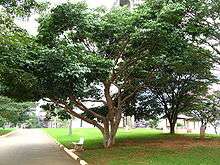Hymenaea courbaril
| Hymenaea courbaril | |
|---|---|
 | |
| Hymenaea courbaril | |
| Scientific classification | |
| Kingdom: | Plantae |
| (unranked): | Angiosperms |
| (unranked): | Eudicots |
| (unranked): | Rosids |
| Order: | Fabales |
| Family: | Fabaceae |
| Genus: | Hymenaea |
| Species: | H. courbaril |
| Binomial name | |
| Hymenaea courbaril L. | |
| Synonyms[1] | |
| |

Hymenaea courbaril, the courbaril,[2] is a tree common to the Caribbean, Central, and South America. It is a hardwood that is used for furniture, flooring and decorative purposes. Its hard pods have an edible dry pulp around the seeds. Its sap, known as animé, is utilized in perfumes and varnishes.
Names
H. courbaril is also commonly known as the locust,[3] specifically the West Indian locust.[4][3] It is also known as the Brazilian copal and the amami-gum.[4]
Although is sometimes referred to as Brazilian cherry or South American cherry, it is not a cherry tree but a legume belonging to the Fabaceae family. It is also known as stinking toe, old man's toe, or stinktoe[5] because of the unpleasant odor of the edible pulp inside its seed pods.[6][7]
Fruits
The fruit were a major food for the indigenous population. The smell is not considered unpleasant by those who eat it. The pulp inside the hard shell appears like miniature soluble fibers that dissolve easily in water or milk, which it thickens. Some like to add sugar for more sweetness, and if eaten raw it can tend to stick in the mouth like dry dust.
It is one of the richest vegetable foods known because of its high concentration of starches and proteins.[8]
The pulp, in spite of it somewhat disagreeable smell, is of a sweet taste, is eaten raw, is also dried and transformed into powder to be incorporated in cookies (or crackers) and soups, or is mixed with water to prepare a drink, called atole. It can also be a first-rate concentrate feed for animals.
Animé
The tree produces an orange, resinous, sticky gum called animé (French for "animated", in reference to its insect-infested natural state). The production of the gum can be encouraged by wounds in the bark, and the resin will collect between the principal roots.[3][9]
This gum is soft and sticky. Its specific gravity varies from 1.054 to 1.057. It melts readily over fire, and softens even with the heat of the mouth. It diffuses white fumes and a very pleasant odor. Insects are generally entrapped in large numbers. It is insoluble in water, and nearly so in cold alcohol. It is allied to copal in its nature and appearance, and a copal from Zanzibar is sometimes given this name. It can be obtained from other species of Hymenaea growing in tropical South America.[3][9]
Brazilians use it internally in diseases of the lungs. It was formerly an ingredient of ointments and plasters, but at present its only use is for varnishes and incense.[9]
The gum will convert to amber through a chemical process that requires millions of years. Amber of million-year-old Hymenaea trees have provided scientists with many clues to its prehistoric presence on Earth as well as to the often extinct insects and plants encased in it, as shown in the Jurassic Park films. (See Dominican amber.)
Wood
The wood is very hard, measuring 5.6 on the Brinell scale or 2,350 lbf (10,500 N) on the Janka scale, approximate measurements of hardness. For comparison, Douglas fir measures 660 lbf (2,900 N), white oak 1,360 lbf (6,000 N), and Brazilian walnut 3,800 lbf (17,000 N) on the Janka scale. It features a tan/salmon color with black accent stripes that over time turns to a deep rich red color.
-

Illustration from an 1891 book (Natürliche Pflanzenfamilien. Vol. III, 3).
-

200-year-old tree in Mococa, Brazil.
References
Citations
- ↑ "The Plant List: A Working List of All Plant Species". Retrieved 26 December 2014.
- ↑ EB (1878).
- 1 2 3 4 EB (1911).
- 1 2 "USDA GRIN Taxonomy". Retrieved 27 December 2014.
- ↑ Mesoamerican Copal Resins from Brian Stross at the University of Texas at Austin
- ↑ Worldwide weird: Bite into a stinking toe from BBC Travel
- ↑ Stinking Toe from StJohnBeachGuide.com
- ↑ Frans Geilfus (1994). El Arbol Al Servico del Agricultor (PDF). 2: Guía de Especies. Turrialba. p. 147. Retrieved 27 December 2014.
- 1 2 3
 Ripley, George; Dana, Charles A., eds. (1879). "Animé". The American Cyclopædia.
Ripley, George; Dana, Charles A., eds. (1879). "Animé". The American Cyclopædia.
Bibliography
- "Animé", Encyclopædia Britannica, 9th ed., Vol. II, New York: Charles Scribner's Sons, 1878, p. 55.
- "Animé", Encyclopædia Britannica, 11th ed., Vol. II, Cambridge: Cambridge University Press, 1911, pp. 52–53.
External links
-
 Media related to Hymenaea courbaril at Wikimedia Commons
Media related to Hymenaea courbaril at Wikimedia Commons